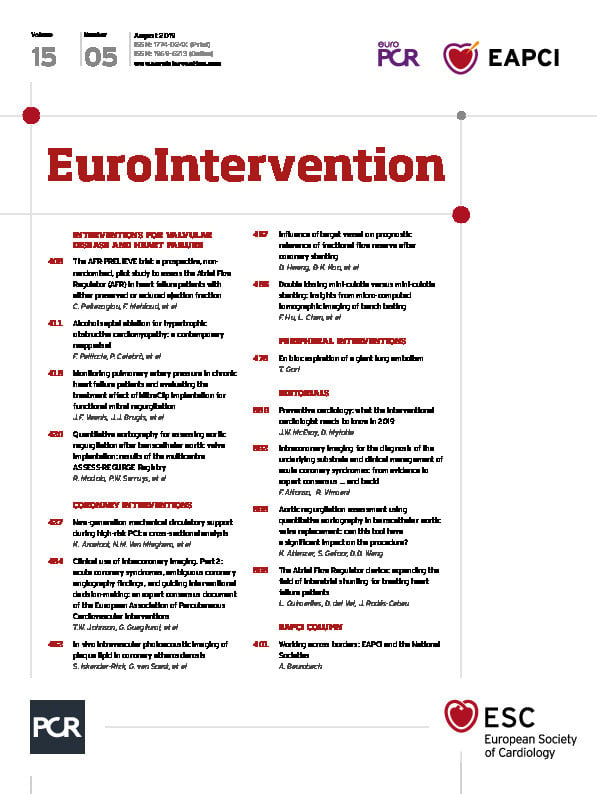
Transcatheter aortic valve replacement (TAVR) is destined to become commercially available for low-risk surgical patients1,2. However, TAVR is still plagued by transcatheter technology’s inability to completely exclude paravalvular regurgitation (PVR). With the arrival of the newer generation of TAVR devices in the USA, the SAPIEN 3 (Edwards Lifesciences, Irvine, CA, USA), the Evolut™ R/PRO (Medtronic, Minneapolis, MN, USA), and the LOTUS Edge™ (Boston Scientific, Marlborough, MA, USA), the incidence of moderate-severe PVR has improved considerably. However, the presence of PVR and, in general, any aortic regurgitation (AR) is associated with increased rates of death and rehospitalisation due to heart failure one year post TAVR3. Therefore, careful intraprocedural post-TAVR deployment evaluation is warranted, as AR severity determines procedural success and long-term clinical outcomes4.
Echocardiography was the first imaging modality for diagnosis of aortic valve disease5. With the transition to conscious sedation-guided TAVR procedures, more and more centres are shying away from intraprocedural echocardiography and relying on aortic root angiography as the tool for post-TAVR AR assessment. However, there are no formalised guidelines for standardising aortography image acquisition, and current methods of evaluation suffer from low reproducibility6,7.
In the ASSESS-REGURGE registry, Modolo et al8 instituted preprocedural patient-specific imaging protocols to derive optimal post-TAVR aortography acquisitions.
In this multicentre evaluation of 354 consecutive TAVR patients, the teams derived angiography projections using three-dimensional (3D) cardiac computed tomography (CCT) reconstructions or periprocedural visual assessment (Teng’s rule)9. Specifically, the periprocedural image protocol standardisation aimed to find the optimal projection where the videodensitometry technique for AR assessment by aortography could be performed demonstrating coaxiality of the aortic annulus and left ventricular outflow tract (LVOT) without overlap with the descending aorta. The primary endpoint of the ASSESS-REGURGE registry was the feasibility of regurgitation analysis. The secondary endpoints were (1) comparison of feasibility results with the RESPOND study10, and (2) the differences in feasibility between the two types of planning, CT versus Teng’s rule.
Amongst the 354 final post-TAVR aortographies, 338 studies were analysable (95% CI: 93.2% to 97.5%). The most common reason for aortography study exclusion was secondary to non-discrete overlapping of anatomy limiting the core lab’s ability to perform accurate videodensitometry (2.82% overlapping descending aorta with LVOT/aortic root)11. Other reasons for non-analysability were breathing motion (0.85%), patient/table movement (0.56%), and <30 frames of acquisition (0.28%). In comparison to the RESPOND trial, of their 996 TAVR cases, 820 had final aortographies of which 348 were non-analysable10.
The authors showed that their method of investing in preprocedural standardisation of aortography imaging was not only feasible but reproducible when compared to the RESPOND trial retrospective method (95.5% vs 57.5%, p<0.0001)8,10. Additionally, they demonstrated no significant difference between the two types of pre-planning method (CCT vs Teng’s method, p=0.159)8. More importantly, the authors of this study should be applauded for identifying a protocol that by concept is achievable and scalable in the real world. The importance of reducing the variability in post-TAVR aortography imaging then opens up a significant opportunity for accurate evaluation of videodensitometry and quantitative assessments of AR using aortography. When implemented, this technique may have less inter-observer variability than traditional short-axis and long-axis echocardiographic image assessments of the aortic valve, as standardisation reduces the potential for introduction of human subjectivity.
However, despite the ability to perform real-world implementation of this assessment tool during the TAVR procedure, the authors are clear in identifying that the impact of this study is not associated with long-term clinical outcomes. The analysis was performed on final aortograms, which indicates that multiple aortograms may have been performed to acquire the most ideal projection for assessment, thereby potentially increasing contrast media load administered to the patients. Higher intraprocedural contrast doses may impact on the occurrence of post-TAVR acute kidney injury (AKI)12,13. Additionally, the quantitative assessment was performed at a core lab and not in real time, which may impact on intraprocedural corrective measures and, potentially, clinical outcomes.
No matter how efficient aortography is in assessing the presence of AR, it is still inferior to transoesophageal echocardiography in delineation of PVR versus central aortic regurgitation post TAVR in single projection imaging. This is important to acknowledge, as not being able to differentiate between the two types of aortic regurgitation can have an influence on the post-TAVR complication corrective methods.
In ASSESS-REGURGE, Modolo et al demonstrated that quantitative aortography evaluation utilising a preprocedural standardised image-guided protocol carried higher fidelity and reproducibility than previous studies on aortography without image-guided anatomical planning8. While this method may improve cardiac catheterisation lab efficiency and reduce costs by the removal of a sonographer for quick AR assessment, it does not allow detection of other intraprocedural complications associated with TAVR, i.e., pericardial effusion or paravalvular versus central aortic insufficiency, and it may not be applied in patients of larger body habitus or compromised renal function. The questions remain: is there a role for CT to identify which patients would benefit from this methodology? What is the learning curve to operate this technology? The need for standardisation is present; the long-term requirement is for this technology to be more versatile in its ability to affect and improve procedural outcomes.
Conflict of interest statement
S. Gafoor is a consultant to Medtronic, Boston Scientific, Abbott, Philips, and Siemens. D.D. Wang is a consultant to Edwards Lifesciences, Boston Scientific, HighLife Medical and Materialise, and receives research grants from Boston Scientific. The other author has no conflicts of interest to declare.

